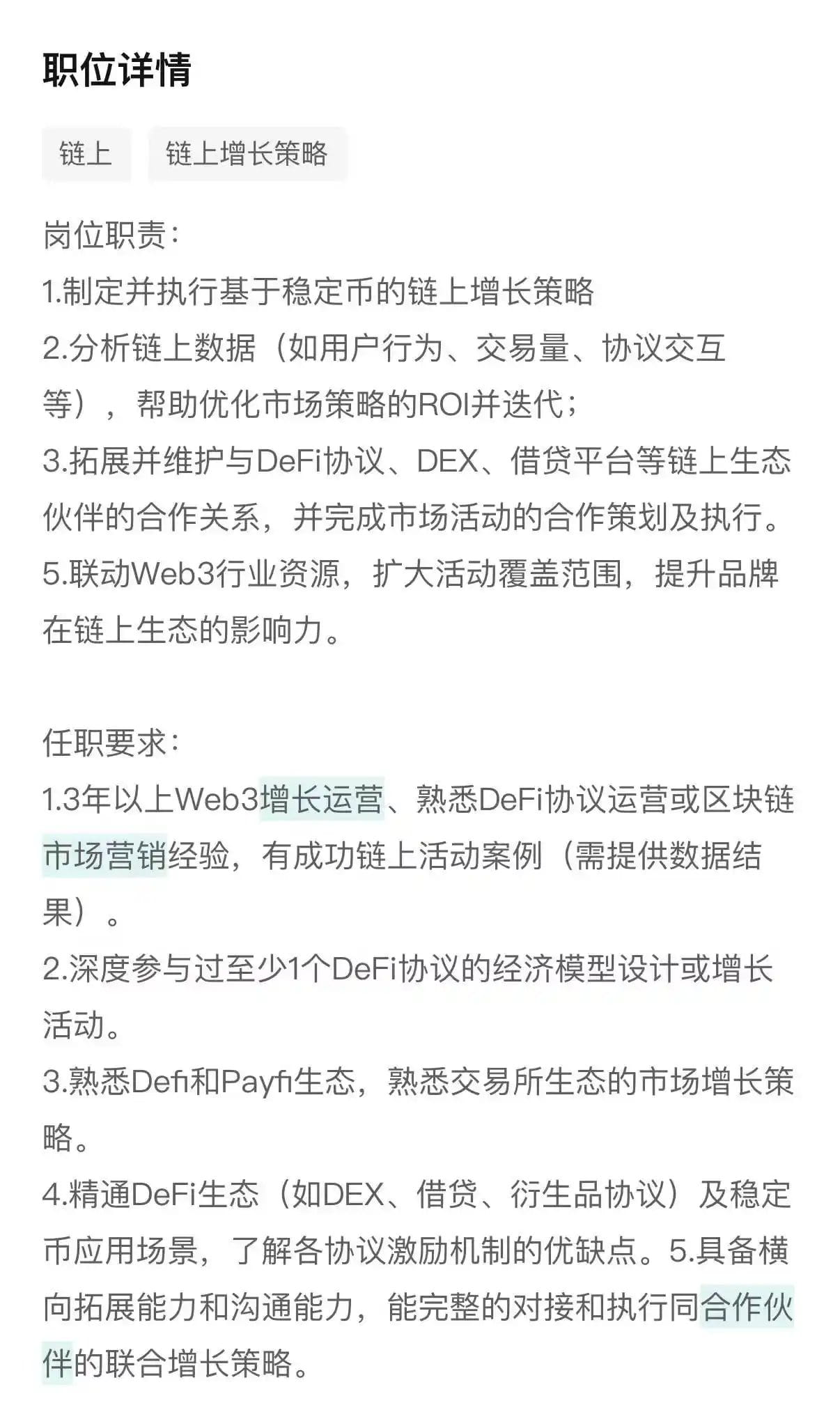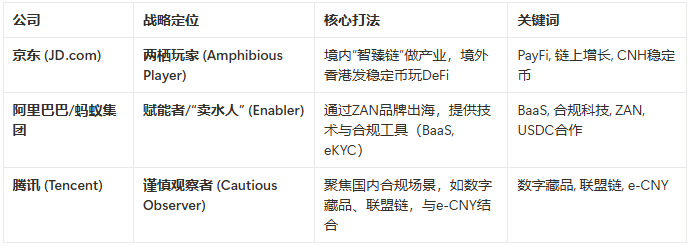Written by: Luke, Mars Finance
A job advertisement can sometimes reveal a company's strategic intent more than an annual financial report.
In August 2025, JD Technology's recruitment information reflects just this. It did not appear on the homepage of mainstream job sites but quietly circulated in the small circle of Web3. What stands out is not the job title 'Stablecoin On-Chain Activity Planner' itself, but its remarkably 'crypto-native' job requirements: 'Deep participation in the economic model design of at least one DeFi protocol,' 'Proficient in DEX, lending, and derivative protocols.'

This is not about finding a fintech expert to optimize internal payments but about 'hunting' for a true on-chain strategist. When an internet giant with over a trillion in annual revenue, rooted in physical retail and supply chains, publicly seeks talent who can thrive in the decentralized world, the signal it sends is unmistakable: JD.com is preparing to place its pieces on the global, permissionless Web3 chessboard.
The 'east wind' from Hong Kong has arrived, and JD.com is seizing the opportunity to enter the market.
JD.com's move is not happening in a vacuum. The timing of the recruitment action precisely corresponds with a key regulatory change in Hong Kong.
Just a few days before the recruitment information surfaced—on August 1, 2025—the long-awaited (stablecoin issuer licensing system) in Hong Kong officially took effect. This means that after multiple rounds of consultations and sandbox tests, the Hong Kong Monetary Authority (HKMA) has rolled out a compliant, clearly defined 'welcome mat' for global stablecoin operators. Therefore, JD.com's 'recruitment' is less an exploration into unknown territories, but rather a precisely calculated move targeting this freshly officially recognized, strategically valuable new global financial frontier.
The Secretary for Financial Services and the Treasury of Hong Kong, Xu Zhengyu, has repeatedly emphasized in public that: 'We support the prudent development of the virtual asset market, viewing stablecoins as a key bridge connecting traditional finance with the virtual asset market, under the premise of ensuring regulation and risk control.'
This tailwind is timely for tech companies like JD.com, which have a vast background in mainland China and aspire to connect with global markets. It provides a perfect 'outlet'—a strategically located point that is legally clear, geographically close, and culturally connected. By establishing a compliant entity in Hong Kong, JD.com can legally issue stablecoins pegged to fiat currencies (such as offshore RMB CNH or HKD), thus bypassing mainland China's strict regulation of cryptocurrencies and directly participating in global on-chain economic activities.
JD.com's recruitment was announced right after the regulations took effect, which is not a coincidence but a well-planned 'seizing the opportunity.' The chessboard is set, and JD.com clearly does not want to just be a spectator.
PayFi: 'Financial Lego' Beyond Payments
If Hong Kong's compliance environment is the 'timing' for JD.com's stablecoin project, then an inconspicuous word in the job description—PayFi—reveals its true 'geography' and core ambition.
PayFi, or Payment Finance, is a concept originating from the crypto-native world. It is far more than just 'paying with cryptocurrency'; its core is to seamlessly combine payment behaviors with complex financial services through smart contracts, granting programmability to every flow of funds.
Imagine a scenario in JD.com's business: a small to medium-sized enterprise that supplies JD.com used to wait up to 90 days to receive payments, facing huge cash flow pressure. What would happen under the PayFi model?
Once JD.com confirms receipt of goods, the system can generate an on-chain certificate (NFT or fungible token) representing this accounts receivable and immediately send it to the supplier. The supplier does not need to wait 90 days but can immediately use this 'digital promissory note' as collateral in a DeFi lending protocol to gain instant liquidity; or it can even be split and traded as payment to upstream raw material suppliers. The entire process is executed automatically by code, efficiently, transparently, and at a very low cost.
This is the power of combining Real World Assets (RWA) tokenization with PayFi, and it is also one of the most exciting narratives in the crypto industry in 2025. Franklin Templeton’s CEO, Jenny Johnson, has asserted: 'We believe that tokenizing real-world assets will reshape the entire financial services industry. This is one of the most significant applications of blockchain technology.'
For JD.com, which has a vast number of merchants, a complex supply chain network, and billions of users, it harbors trillions of 'real-world assets'—accounts receivable, warehouse receipts, logistics orders, consumer credit. Activating these assets on-chain through stablecoins and the PayFi model is akin to unblocking the body's meridians, and the energy it can release will be exponential. This not only reduces costs and increases efficiency for existing supply chain finance operations but also creates a brand new, programmable financial infrastructure.
'Amphibious warfare': The different Web3 paths of the giants.
JD.com's clear focus on stablecoins and DeFi has led it to carve out a distinctly different path in the Web3 exploration among China’s tech giants. If we compare horizontally, we find an interesting picture:

As shown in the table above, Ant Group under Alibaba seems more like a 'water seller' in its Web3 layout. Its ZAN brand launched in Hong Kong focuses on providing e-KYC (electronic identity verification), AML (anti-money laundering), and other compliance technology components and BaaS (Blockchain as a Service) for Web3 developers. Its strategy is to 'empower', helping others better 'strike gold' rather than personally diving into the field. Recent news about its proprietary chain plan integrating the USDC stablecoin also confirms its inclination to collaborate with mature ecosystems rather than starting from scratch.
Tencent, on the other hand, is more cautious, with its actions largely revolving around alliance chains and digital collectibles in areas with clear domestic policies, maintaining a considerable distance from the public chain world.
In this context, JD.com's strategy appears particularly unique and aggressive. It has not settled for merely being a technology service provider but has chosen an 'amphibious warfare' path:
Internally: Its self-developed 'Smart Chain' continues to delve into industry blockchain under a permissioned environment, serving anti-counterfeiting traceability, digital certification, etc., embracing regulation, and connecting with digital RMB (e-CNY) to strengthen the compliant 'digitalization of industries' foundation.
Externally: It utilizes Hong Kong as a window to personally engage as a 'player', issuing its own stablecoin, operating its own on-chain ecosystem, directly fishing in the vast ocean of DeFi, exploring the stars and seas of 'financial assetization.'
This dual-track strategy ensures the stability and compliance of domestic operations while opening up limitless possibilities for the group's future.
From E-commerce Empire to On-Chain Economy
This step by JD.com marks an important turning point. It signifies that the integration of top Web2 giants with Web3 is transitioning from theoretical discussion and peripheral experimentation to deep integration with core business.
In the past, people often discussed how Web3 would 'disrupt' Web2. But JD.com's case may reveal another possibility: not disruption, but 'elevation.' Web2 giants will not be easily replaced; they will leverage their massive user bases, rich application scenarios, and strong capital to absorb the technologies and ideas of Web3, evolving into a new, more powerful hybrid form.
Of course, the road ahead is not smooth. From hiring for a position to truly establishing a prosperous on-chain ecosystem, JD.com needs to overcome multiple barriers including technology integration, financial compliance, market education, and user habits. It will face not only scrutiny from traditional financial institutions but also fierce competition from the crypto-native world.
However, when JD.com, a trillion-level commercial giant, begins to adjust its course and navigate into the deep waters of DeFi, the entire industry should pay close attention. Because this concerns not just the future of one company, but may also be painting a blueprint for us: how an e-commerce empire, through the bridge of stablecoins, ultimately evolves into an efficient, transparent, and global on-chain economy. On that day, the end of a transaction will no longer be the completion of payment, but the beginning of another phase of financial value creation.



